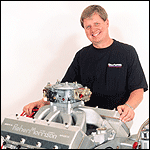By David Reher, Reher-Morrison Racing Engines
“My goal was to encourage readers to think seriously about the topics I wrote about.”
One hundred is just a number – one more than 99, one less than 101. Yet racers see significance in certain numerals, from Eddie Hill’s “First in the Fours” to Lee Shepherd recording the first
seven-second run in NHRA Pro Stock. So as I write my 100th column for National Dragster, I’ve finally reached the finish line.
When I began writing Technically Speaking in 1998, I had no notion that the column would run for 19 years. I want to thank Editor Phil Burgess for giving me the pages in National Dragster, and his staff who translated my ramblings into proper English. I also want to acknowledge the racers, fans, and officials who complimented and critiqued my words.
In my first column, I laid out my plan: “I intend this page to be a place where bracket racers and weekend warriors can get practical, hands-on advice about engines.” Looking back over 99 columns, I believe I remained true to that mission statement . . . despite a few digressions into Chaos Theory and World War II airplane engines. It means a lot to me when a racer stops me in the staging lane and says, “Hey, Reher, you really nailed it in your last column,” or a fan tells me in a motel lobby, “David, I learned something when I read what you’d written in Dragster.” Occasionally my intelligence was called into question when someone disagreed with what I’d written, but that’s fine with me – my goal was to encourage readers to think seriously about the topics I wrote about, even if they didn’t share my perspective.
When I began as a rookie columnist in 1998, I was obsessed with Pro Stock. My partners Buddy Morrison, Bruce Allen, and I were chasing thousandths of a second, and I was convinced that Pro Stock was the center of the universe. I’d lose sleep worrying about whether to add half a gram to the clutch counterweight, and I would agonize over the next qualifying session. At the time, I regarded this intensity as being my laser focus on the details. In retrospect, it was probably tunnel vision. After Bruce and I retired from competition and our business expanded to embrace a wider variety of racing, from Pro Mods and tractor pulls to Bonneville cars and turbocharged Sport Compacts, I learned to appreciate the knowledge that has developed in different disciplines of motorsports. Being involved in these diverse projects has made me a smarter and sharper engine builder.
Before I sat down to write this final column, I reviewed what I’d written over the years. (For anyone interested, all of my previous columns are archived under the “Tech Talk” tab on rehermorrison.com.) As I read those long-forgotten words, some common themes emerged.
One of the recurring topics is that this is the Golden Age of engine building. When Buddy and I started our business in the back room of Mansfield Auto Supply in 1971, our parts selection was chiefly determined by what we could scrounge in a junkyard. We used worn-out blocks and cast-off cylinder heads, assembling engines with parts from the TRW catalog and the latest trick stuff from California (usually delivered on a Greyhound bus). Later we won Pro Stock championships with a block and a crankshaft that we’d bought from an engine rebuilder for $50. When Lee Shepherd was porting our cylinder heads, we were utterly dependent on whatever new castings came out of Detroit.
Now contrast that to today’s selection of aftermarket components. There are literally hundreds of engine block and cylinder head designs on the market. If a racer wants something special, a billet of aluminum can be machined to any imaginable configuration. Advances in materials, metallurgy, and CNC machining have enabled manufacturers to produce valve springs, crankshafts, connecting rods, pistons, and other parts that were simply unimaginable when we were racing our Chevy-powered Modified Production Maverick at hole-in-the-wall drag strips.
Another topic I have returned to frequently has been the impact of computers and the Internet, for better and for worse. Information has never been more easily available – as well as misinformation. There is no shortage of online experts who freely dispense advice, regardless of its value or relationship to reality. I admit that I am biased, but anyone who is planning to invest thousands of dollars in a race car really should consult with professionals who have experience and expertise with engines, chassis, and drivetrains – not just computer keyboards. It’s easy to be seduced by shiny CNC-machined parts and big airflow numbers, but it takes a pro who has devoted years to real-world track and dyno testing to determine how well these parts actually perform. Readers of this esteemed publication know who the real players are in this industry, and I urge them to seek them out before spending their racing dollars.
Surprisingly, one of the columns that generated the most response had nothing to do with engines. In April 2000, I posed the question, “Why do I encounter so many unhappy people at the races?” Listening to constant complaints about everything from the starting line to the track food, you would think that racers were forced to go to the track at gunpoint. So how does an activity that is supposed to be fun and fulfilling become a source of discontent? It’s easy to forget what attracts a person to racing in the first place – the competition, the challenge, the camaraderie, and the adrenalin rush of driving a fast car.
Racing is like a trip – you should enjoy the journey, not just focus on the destination. So I’ll sign off with my final observation: A bad day at the drag races is still better than a good day anywhere else.

